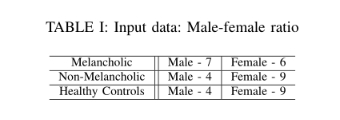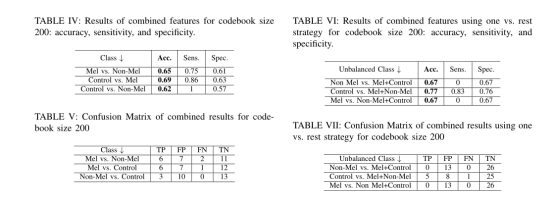1. 文献信息:题目——发表期刊/会议名称——发表年份;
A Video-Based Facial Behaviour Analysis Approach to Melancholia--International Conference on Automatic Face & Gesture Recognition--2017
2. 摘要内容是什么?(要理解人家如何写摘要的)
复制文献中的摘要内容过来 (为以后写文献综述做准备,不能截图)
Abstract—Recent years have seen a lot of activity in affective computing for automated analysis of depression. However, no research has so far directly evaluated the performance of facial behavioural analysis methods in classifying different subtypes of depression such as melancholia. The mental state assessment of a mood disorder depends largely on appearance, behaviour, speech, thought, perception, mood and facial affect. Mood and facial affect mainly contribute to distinguishing melancholia from non-melancholia. These are assessed by clinicians, and hence vulnerable to subjective judgement. As a result, clinical assessment alone may not accurately capture the presence or absence of specific disorders such as melancholia, a distressing condition whose presence has important treatment implications. Melancholia is characterised by severe anhedonia and psychomotor disturbance, which can be a mix of motor retardation with periods of superimposed agitation. To the best of our knowledge, this study is the first attempt to perform facial behavioural analysis to disambiguate melancholia from non-melancholia and healthy controls on the basis of facial behavioural characteristics. We report the sensitivity and specificity of classification in depressive subtypes. These results serve as a baseline for more fine-grained depression classification and analysis.
3. 拟解决的问题(Motivation)
在摘要或引言(一般快结尾处)中找
复制文献中的相关内容过来(不能截图)
Despite rapid advances in research and technology, there
have been no non-invasive and inexpensive markers for di-
agnosis and prediction of depression. Hence, there is a need
to establish and validate objective measures for identification,
prediction and treatment of depression. The interdisciplinary
field of affective computing – which spans computer science,
psychology, and cognitive science – has the potential to
achieve this goal.
尽管研究和技术取得了迅速的进步,但还没有一种非侵入性的、廉价的标志物来诊断和预测抑郁症。因此,有必要建立和验证鉴别、预测和治疗抑郁症的客观措施。情感计算的跨学科领域——跨越计算机科学、心理学和认知科学——有可能实现这一目标。
4. 解决方法(Method)
方法有原理图的,给出原理图(截图过来),并且要给出原理图步骤的概括性语言描述(复制文献中的相关内容过来,不能截图);没有原理图的,要给出方法Method的基本思想的语言描述(复制下,不能截图)。
In this paper, we report on a study to investigate facial behaviour analysis methods that can characterise melancholia from non-melancholic major depression and healthy controls using direct methods, such as the supervised descent method [15], and indirect methods, such as Local Binary Patterns in Three Orthogonal Planes (LBP-TOP) [16] and Bag of Words [17]. These methods are designed to capture the facial geometry and appearance from videos of participants that were recorded during an interview with a clinician.
在本文中,我们报告的一项研究调查面部行为分析方法,可以描述忧郁症non-melancholic抑郁症和健康对照组使用直接方法,监督下降法等[15],和间接方法,如局部二进制模式在三个正交平面(LBP-TOP)[16]和袋的话[17]。这些方法的目的是从临床医生的访谈中记录的参与者的视频中捕捉面部几何形状和外观。
5. 实验结果及分析 (Results)
什么数据集,实验参数如何设置的,实验结果怎样?截图过来即可。
Our approach to characterising melancholia from non-melancholia and healthy controls comprises of three modules. First, given an input video of facial images, facial regions of interest are detected and aligned (Section IV-A). Next, a discriminative feature representation of the video is found (Section IV-B), which is then passed to a classifier (Section IV-C), as shown in Figure 2.
我们从非忧郁症和健康对照中区分忧郁症的方法由三个模块组成。首先,给定一个面部图像的输入视频,检测感兴趣的面部区域并对齐(IV-A节)。接下来,找到视频的鉴别特征表示(IV-B节),然后将其传递给分类器(IV-C节),如图2所示。

Experimentally it has been shown before that the motion of a set of landmark points on a face, when exhibiting a particular facial expression, is similar across different people. Hence, for facial image analysis, 49 fiducial points (eyebrows, eyes, nose and mouth) were detected. Face detection and alignment was done using subject-independent regression based on the supervised descent method [15], which is trained based on the mean pose deduced from the Viola-Jones face detector [34]. The supervised descent method is invariant to changes in pose and illumination and also partially occluded faces (such as eye glasses). For each of the 49 fiducial points, the (x, y) locations in image coordinates were stored for each video frame of the interview part of the dataset.

Texture Features: Zhao et al. [16] showed that appearance based features are more effective in expression analysis, as they are able to capture subtle facial movements, which are difficult to capture otherwise using shape based features. In this study, texture features are extracted using LBP-TOP [16], which considers patterns in three orthogonal planes: XY , XT and YT, and concatenates the pattern co-occurrences in these three directions. The local binary pattern part of the LBP-TOP descriptor assigns binary labels to pixels by thresholding the neighbourhood pixels with the central value.
对齐帧大小为166×178像素,但由于访谈长度的不同,每个视频的帧数都不相同。剪辑计数c是通过帧数除以选择的不重叠剪辑长度(在本研究中为150)来计算的。将图像转换为灰度,调整为128×128像素,并分成64×64×150的4个块。从这些块中提取LBP- top特征,形成大小为708的clip feature(在一个平面上有59维的LBP,因此在3个平面、4个块上有59×3×4)。重复进行clip count,形成大小为c×708的feature vector。所有39个视频都重复了这个过程。
6. 总结/结论(Conclusions)
截图过来即可。



7. 还存在什么问题(Inspirations)
一般文章结尾处(conclusions and future work或discussion)可以找这个。
复制相关文字内容过来(不能截图)
Both categorical and dimensional approaches are relevant to affective states such as depression. The categorical approach arguably provides a more accurate measure of a current temporary experience of emotion. The dimensional approach is more relevant to the temporal experience of affect such as mood. The next question is whether complex affect, as seen in the case of melancholic depression, can be conceptualised dimensionally and, if it can be, then can measuring this complex affect on a continuous scale help improve the classification accuracy of depressive sub-types? Another future direction is to detect subtle changes or micro expressions, as in the case of melancholic depression, to further improve the classification accuracy. The fusion of multiple modalities such as audio and video in estimating depression severity also need to be explored.
分类和维度方法都与情感状态有关,比如抑郁。绝对的方法可以说是对当前暂时的情绪体验提供了更准确的测量。维度方法与情感的暂时体验(如情绪)更相关。下一个问题是,在抑郁症案例中所见的复杂情感,是否可以从维度上概念化,如果可以,那么在连续尺度上测量这种复杂情感是否有助于提高抑郁亚型的分类准确性?另一个未来的方向是检测细微的变化或微表情,如在抑郁症的情况下,进一步提高分类的准确性。多种模式(如音频和视频)在评估抑郁严重程度上的融合也需要探索。
8. 写作有什么特点:
8.1文章的整个结构包含那几个部分?
1.摘要 2.引言 3.相关工作 4.数据 5.方法 6.结果和讨论 7.结论和未来的工作
8.2引言(Introduction)撰写如何组织的?(找出“引言”中每一段话的中心句,或自己总结出中心句)
第1段:虽然这些可能是直接和容易理解的,但它们不能用于检测抑郁的亚型。在追踪疾病严重程度的细微变化或预测结果方面,它们的效用也有限。这些方法的另一个缺点是诊断需要医生在场,而且时间很长。
第2段:因此,有必要建立和验证鉴别、预测和治疗抑郁症的客观措施
第3段:虽然这些症状都可能出现在任何MDD发作中,但它们的共同出现和明显的严重程度足以成为忧郁症的特征。忧郁症也可以通过病人的历史因素来区分,比如没有明显的外部诱因(比如生活中的主要压力源)和过去对治疗的反应。
第4段:长期以来在精神病学上存在争议的是抑郁症的分类问题。Kessing等人[3]认为抑郁症的发病率是动态的,是在一个连续的量表上发展的,这表明抑郁症是维度的而不是分类的
第5段:因此,抑郁症的分类仍然存在争议。临床研究将抑郁确定为一个分类实体,而发病率研究表明抑郁是动态的,并在一个连续的规模上发展。
8.3有什么语言表达优美的好句子可以摘录下来,供以后写作借鉴?例如,如何看“图”说话、看“表”说话、如何描述不同方法的性能高低和比较,如何表述因果关系。。。。等等。(摘录2-4个好句子)
好句子复制过来即可(不能截图)。
1.One of the controversies existing in psychiatry for a long
time is the classification of depression. Kessing et al. [3] state
that the incidence of depression is dynamic and develops on
a continuous scale, which suggests that depressive disorders
are dimensional rather than categorical.
2. Our approach to characterising melancholia from nonmelancholia and healthy controls comprises of three modules. First, given an input video of facial images, facial regions of interest are detected and aligned (Section IV-A). Next, a discriminative feature representation of the video is found (Section IV-B), which is then passed to a classifier (Section IV-C), as shown in Figure 2.
我们从非忧郁症和健康对照中区分忧郁症的方法由三个模块组成。首先,给定一个面部图像的输入视频,检测感兴趣的面部区域并对齐(IV-A节)。接下来,找到视频的鉴别特征表示(IV-B节),然后将其传递给分类器(IV-C节),如图2所示。
3. Experimentally it has been shown before that the motion of a set of landmark points on a face, when exhibiting a particular facial expression, is similar across different people.
之前的实验表明,当一个人呈现出特定的面部表情时,脸部的一组标志性点的运动在不同的人之间是相似的。



